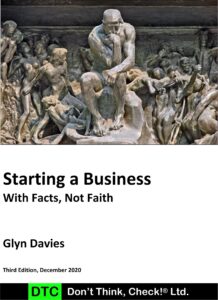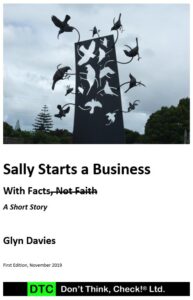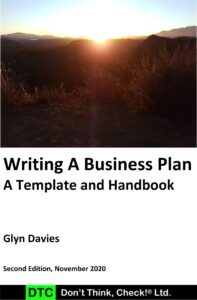
Summary
It’s easy to pronounce that the first thing you need in business is a Job To Be Done, for which you will develop a solution. But just how do you go about finding a Job To Be Done?
The following is a slightly adapted extract from the book Starting a Business With Facts, Not Faith, reproduced for your convenience.
Identifying a Job To Be Done
Customer Jobs To Be Done (JTBD) describe in the customers’ words what they are trying to accomplish. Identifying and satisfying customers’ JTBD can be summarised as “see a need, fill a need,” Bigweld in the movie Robots, 20th Century Fox.
The theory of JTBD recognises that jobs are stable and exist independent of there being a market for solutions for those JTBD. For example, humans have needed to be mobile before the development of shoes, the domestication of horses, and well before the invention of the automobile.
At the start, we are looking for any jobs that prospective customers are trying to accomplish, but ultimately, since we need to focus our limited resources, we will need to select the most important jobs.
The late Clayton Christensen explains JTBD in a video accessible via this link[1] and provides this definition:
A job is defined as the progress that a customer[2] desires to make in a particular circumstance.
The Theory of Jobs to Be Done requires that we:
- Focus on deeply understanding the customers’ struggle for progress, in specific contexts.
- Understand the trade-offs the customers’ are willing to make, the set of competing solutions that must be beaten, and the anxieties that must be overcome.
- Create the right solution system with an attendant set of experiences that satisfies the customers’ functional, social, and emotional requirements, that solves the customers’ jobs well, every time.
It is not about products [or services] as such. Competing Against Luck, Clayton Christensen.
Click on the link for trigger questions from Strategyzer – Customer Jobs To Be Done Trigger Questions[3].
List as many JTBD as you can and then in your final iteration through the template (The Leaner(ish) Canvas, a stepping stone to completing the Lean Canvas, and subsequently The Business Model Canvas), only list the top three, from which you will ultimately pick one to follow through with.
If you cannot identify any JTBD then stop. You need to know who the customer is (see Customer Segments below) and what they are trying to accomplish. If you can’t, you won’t be able to create a Business Model, much less one that works.
Finding Jobs To Be Done
So how do you go about identifying and then validating jobs to be done?
There is more than one way to identify jobs to be done, and often there isn’t a clear demarcation between the identification and validation phases.
The answer to the second part of the question is one of the main themes of the book Starting a Business With Facts, Not Faith; following the scientific method to verify that there is a job to be done for which it is worth building a business to satisfy.
A partial answer to the first part of the question above is that you need to be observant; for example, if you don’t bother to look, you may not realise that your floor is overdue for a vacuum. Likewise, when moving through your environment; if you are not observant, inquisitive, and empathetic about what is going on around you, you may never see people struggling with their jobs that need doing.
In 1999, Tony Hsieh, was curious, was it possible to profitably sell shoes via an online internet store? Tony had no prior experience selling shoes, but he knew about building websites. All he needed was some shoes to sell. Instead of buying shoes to sell, Tony went to a shoe store and took photos of their stock and posted those promotional photos on his new website.
Before long, Tony had enquiries and then sales, but then he also had a problem – he didn’t have any shoes in his possession to sell. With every online purchase, Tony went to the shoe store, bought the shoes he had presold, and sent them to his new customers. This model was not sustainable as Tony was losing money on each sale. But what Tony had done was loosely follow the scientific method; form a hypothesis (can I sell shoes online?), develop a cost-effective experiment (build website with photos of shoes), run the experiment (promote the website and record what happens), analyse the results, and then he had choices to make:
- Abandon the experiment – an initially appealing concept but ultimately futile.
- Pivot and try something else – say sell beanies for golf clubs.
- Expand the experiment parameters – modify aspects of the experiment, such as increase or decrease range of shoes.
- Amplify what works – judge the experiment to be a success; shoes can be sold online, and scale the experiment into a full-sized business.
In the end, Tony and his partners founded Zappos[4], which Amazon bought in 2009 for $1.2billion, Delivering Happiness, Tony Hsieh, 2010.
Not everyone can be successful like Tony, but as successful as he was, it still wasn’t a straight unencumbered path from experimenting in 1999 to a big pot of gold in 2009.
One final example concerns someone I knew who started a restaurant. This person went straight from ‘brilliant idea’ to opening a Vietnamese restaurant in one leap and spent a large amount of money to do so, and ultimately was not successful.
The following table suggests some alternative steps to the gamble, in this case, of starting a business, a restaurant in this case, in a single leap:
| Step | Description |
| Form a hypothesis or a coherent set of hypotheses | Hypothesis-1: You make food that people you know enjoy; maybe strangers will pay you to make food for them. Hypothesis-2: The most obvious location for your restaurant is Hope Street, as it is near your home and there are other restaurants there as well. Hypothesis-3: You will enjoy making food for others as a full-time job, often working late into the night to do so. Hypothesis-4: There is sufficient demand in the area of Hope Street to support another restaurant. |
| Develop and run a cost-effective experiment to prove or disprove the hypotheses and record what happens. | Perform a Break-even Analysis to determine the minimum volume of food you need to sell in your restaurant. This will be, by necessity, an estimate that you can review and revise as you learn more. Develop an experiment – walk down the street in themed costume with a platter of giveaway samples; next time try to sell the samples. Design and make bite-sized portions of food and place on a platter. Develop a questionnaire for customers to determine their views on your food. Select the streets on which to experiment, on or around Hope Street. Arrange for an accomplice to help you with the logistics, such as assisting with the platter, taking money from customers, making change for customers, and surveying customers and non-customers. Both you and the accomplice dress in traditional costume and attempt to give the food away – do people take your free food? What do they say about it? At some other time, try to sell the food – do people buy your food? What do they say about your food? Go to the local Saturday and Sunday markets and repeat the above in some manner, such as by wandering about as above or by arranging a stall. |
| Analyse the results and learn. | Were you able to sell any food? What did people buy and in what quantities? Were you able to determine why you got the results you did? How does the volume of sales compare with your Break-even Analysis? What does this say about the demand? Is that demand likely to be sustainable and support a restaurant? Did you enjoy the process of preparing, marketing, and selling food? Are you likely to enjoy doing this 5-7 days a week? From the lessons you have learnt, do you need to learn more? If so, can you modify the experiment and repeat to learn more? What do the results suggest; amplify or scale what worked, pivot, or abandon? If the results indicate that scaling might work, what do you do? Investigate hiring a food cart or caravan, and if that is successful, then look at opening a restaurant, or do you head straight to opening a restaurant? |
| Modify | From what you have learnt, modify your hypotheses and or your experiments to match your observations, that is, reality better. |
| Repeat | Repeat the above with either a modified or a new experiment until, you have developed a sound and coherent set of hypotheses which you have proven, or you have pivoted and developed new hypotheses which you will test, or you have abandoned the exercise as you cannot develop a valid set of hypotheses and the situation can’t be salvaged. |
| Act | Act on what you have learnt by either going forward and developing a restaurant or abandoning this quest in favour of something else. |
To summarise, identifying and satisfying a JTBD with a solution is some combination of observation, empathy, inquisitiveness, a desire for adventure, and figuring out what to do with what you know, who you know, and the resources you have, all to get to the stage where you have what you need to provide a complete solution.
Few of us can take the cognitive or financial leap from brilliant idea to fully formed solution and successful business; we need to make our journey one small step at a time within our current means.
The process sketched out above is modelled on both Lean processes and the scientific method; beginning with a hypothesis, you do what you can with what you have to learn more, in short, taking small incremental risks (steps), learning, amplifying what works and dampening what doesn’t, and then repeating. The process avoids the straight-out gambles.
When we look about us, all we see are the outcomes of countless experiments. We don’t know of the time, blood, sweat, tears, and wealth that went into creating the final solutions, and neither is it apparent the often tortuous journey that the entrepreneurs had to traverse to make their solutions available to us.
Customer Segments
We need to identify the most likely group of all possible customers, also called a target Customer Segment, that will buy our solution.
We focus on a target Customer Segment to both reduce waste, as there is little point to make things for people who don’t want our solution, and because of limited resources, we need to concentrate our limited resources where they will be most effective; it is futile to try to be everything for everybody.
Customer Segments can be distinguished by such things as their different needs, their profitability, the channel by which they are reached, and the relationships they are after.
For example, assuming your solution is bicycles for 5-9-year-old girls, then your solution would look different to bicycles for 55-65-year-old men. In some cases, you may be physically able to develop and deliver solutions for a wide range of customers, say swimwear for teenage girls as well as for elderly women, but you likely then run into problems with identity and branding – there’s a high probability that you’re not going to get many teenage girls buying their swimwear from the same shop that sells Grandma swimsuits, and vice versa.
There is a difference between Customers and Users, with the distinction being that Customers pay and use your solution, whereas Users use your solution and don’t pay.
Identifying customers is ultimately our goal here, but users can be useful to get early feedback on the first versions of our solution.
If you don’t know who your customers are, then stop. Without customers, you won’t be able to build a Business Model that works.
[1] https://www.dontthinkcheck.co.nz/blog/sab-wfnf-3rd-edition-resources/
[2] http://www.dontthinkcheck.co.nz/glossary/customer/
[3] https://assets.strategyzer.com/assets/resources/customer-jobs-trigger-questions.pdf



